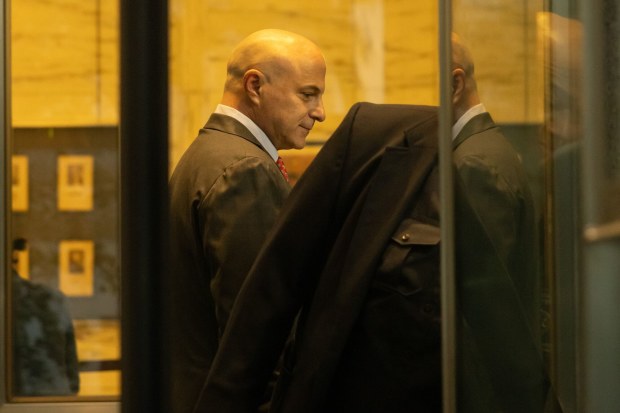Morgan Stanley FX head testifies bank restricts barrier trades
Morgan Stanley’s head of foreign exchange trading testified at the fraud trial of a hedge fund co-founder accused of manipulating the market to trigger a “barrier” option sold by the bank, saying it prohibits such conduct among its own traders.

Neil Phillips, co-founder and chief investment officer at Glen Point, in New York on Monday. Yuki Iwamura/Bloomberg
Samer Oweida took the stand on Wednesday as a government witness against Glen Point Capital’s Neil Phillips, who is on trial in New York. Federal prosecutors claim Phillips directed $US725 million ($1.15 billion) in trades on December 26, 2017, to drive up the value of the South African rand against the US dollar to a barrier rate at which a $US20 million option would pay off.
As Glen Point’s counterparty on the option, Morgan Stanley was the fund’s alleged victim. Phillips’ lawyers are arguing that his trades fell within standard industry practices of barrier chasing and defending. The defence has claimed that Morgan Stanley would have anticipated Phillips’ actions and engaged in barrier trading against him over the rand-dollar pair.
Under questioning by Assistant US Attorney Kiersten Ann Fletcher, Oweida said Morgan Stanley doesn’t permit spot trades intended to move the underlying rate or to trigger a barrier rate. He also said “it would be important” to know if a counterparty planned to make such trades.
When such barriers are triggered, Morgan Stanley presumes that its counterparty’s trades are legitimate, he said. Oweida additionally testified that Morgan Stanley, as a currency market maker, doesn’t price in the possibility that a counterparty will move markets to trigger a barrier.
The testimony was perhaps the strongest that prosecutors have put on in the case to date, though Oweida was only speaking in general terms. He was Morgan Stanley’s Americas foreign exchange sales head in 2017, but he was not involved in selling the option to Glen Point or in the bank’s own rand-dollar trading.
Phillips’ lawyers had objected to Oweida’s testimony due to his lack of direct involvement in the events at issue.
‘Next best thing’
“They couldn’t get the people who participated so they got the next best thing,” Sean Hecker, an attorney for Phillips, said outside the presence of the jury. “At some point it gets a little aburdist, this trial, honestly.”
US District Judge Lewis J Liman allowed Oweida’s testimony but said the defence could cross-examine him about whether market participants expect trading around barrier limits.
Under questioning by Hecker, Oweida said Morgan Stanley takes a variety of methods to reduce its risk from currency transactions and understands that counterparties will also hedge. Oweida acknowledged that both sides’ actions could affect the likelihood of a barrier event.
The broker who arranged Glen Point’s roughly $US2 million purchase of the option from Morgan Stanley in October 2017 testified on Tuesday that the bank tried to buy it back for $US13 million just a week before Phillips began his flurry of rand-purchasing.
The testimony by Graeme Henderson of JB Drax potentially bolsters the defence argument that Morgan Stanley would have recognised and anticipated Phillips’ trading strategy.
The case is US v Phillips, 22-cr-138, US District Court, Southern District of New York (Manhattan).
Bloomberg
Introducing your Newsfeed
Follow the topics, people and companies that matter to you.
Find out moreRead More
Latest In Currencies
Fetching latest articles